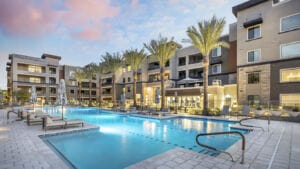What are the trends CoreNet Global Arizona is watching?
The working world has changed dramatically. And, as the way we work continues to evolve, the “where we work” is keeping pace right along with it. A corporate real estate executive leads the team responsible for not only locating the right facilities to meet the demands of our ever-changing business, but also adapting current facilities to meet the needs of our employees. With technology advancements emerging at breakneck speeds, a significant rise in the availability of high-quality, sustainable materials and the challenges that come with establishing a local market presence and driving down real estate costs, I find that a corporate real estate executive’s job is never done.
Real estate, business and IT professionals must work together to establish new ways to accommodate this new world of work. Setting a corporate real estate strategy for the future of work is challenging. It must include efficient workflow dynamics that support the business as well as provide an atmosphere that is beneficial to the well-being of employees, now inclusive of the Millennial. It’s a tall order but one made much easier by new innovations in everything from furniture, carpet, workflow design to paint colors to the cloud.
What are CoreNet members most passionate about this year?
The networking, learning and challenges ahead that we face.
A challenge that many companies run into as they face the new technology-connected Millennial workforce is excess space. For example, if a company has been operating in a 5KSF facility for five years and now realizes that only 50 percent of its employees are there at one time, this is a good opportunity to rethink the utilization of the space. Ultimately, employees don’t want to work in a half-empty building. Giving employees the opportunity to work in closer quarters helps them feel more energized and more connected as a team. This means consolidating space and giving employees more options for the type of work space with significant designs to meet the need of all along with the emphasis of the Millennial work habits.
Readying for the workplace of the future also requires implementing sustainable materials. When my team first started deploying “greening effects” in our facilities it was because we knew that the return on investment was there. We started with simple changes like more efficient lighting that cut down on our carbon footprint — and our electric bills — and low-flow toilets that cut down on our water usage. As sustainable products improve, it continues to make sense to utilize them when building and retrofitting our facilities.
Today, we’ve established very high-end standards around the materials we use, paying close attention to the latest trends in the sustainable marketplace. Everyone likes to do things for the community, environment and this really attracts a Millennial worker knowing the company he/she works for is conscious of this. We choose carpets made from recycled materials, T5 and LED lighting, furniture made from sustainable materials, etc. We have made a conscious decision to continue using green materials because we know it’s a good decision: good for the environment, good for our employees, good for the communities we work in and good for business.
CoreNet is all over this type of approach to change to meeting the needs of the worker while supporting the cost containment of the enterprise.
Are property managers playing a larger/different role in how corporate end users approach their existing/prospective real estate choices?
(Developers) have seen the benefits of involving a property manager (PM) earlier in the leasing and design development phase of projects. Operating expenses are a large part of a tenant’s occupancy cost so the language in the leases dealing with this gets a lot of scrutiny. They ask their PMs to review this language and they provide valuable input. Tenants are using their premises extensively after normal operating hours so the demand for access, HVAC, janitorial and other services has increased. This falls under the PMs responsibility to not only make sure the services are provided but accurately billed pursuant to the lease terms. The design of the building must accommodate these functions so we look to our PM for input on the plans. The additional revenue to the building owner from after-hour usage can be significant and affect the sale value of the building. More importantly, how happy the tenants are with their premises is largely a result of how well the PM does his or her part. This may affect whether the tenant renews a lease or leaves the building upon expiration of the term. Tenant turn-over is expensive to the owner, so a good PM can easily pay for their fee if tenants are satisfied with the service they receive and stay in the building.




